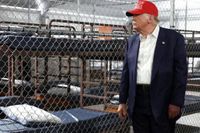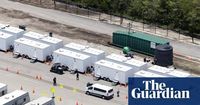Deep in the wild heart of the Florida Everglades, a controversial immigration detention center—dubbed "Alligator Alcatraz"—now faces an uncertain future after a federal judge issued a sweeping preliminary injunction on August 21, 2025. This decision, handed down by U.S. District Judge Kathleen Williams, halts any further expansion and orders a gradual wind-down of the facility, which has become a flashpoint in the national debate over immigration enforcement, environmental protection, and tribal sovereignty.
The detention center, officially located at the Dade-Collier Training and Transition facility in Ochopee, Florida, sits squarely within the Big Cypress National Preserve, a region with a storied history of both environmental preservation and political controversy. The facility first began operations in June 2025, constructed in a whirlwind eight-day effort by the Florida Division of Emergency Management, with an eye toward housing up to 4,000 detainees. At present, it holds about 900 people—though at times, reports suggest several hundred have been crammed into temporary tent structures surrounded by chain-link fencing and glaring industrial lights, all in the midst of one of the world’s most unique wetlands.
Judge Williams’ ruling formalized a temporary halt she had imposed two weeks earlier, as testimony unfolded in a multi-day hearing. The injunction came after environmental groups, including Friends of the Everglades and the Center for Biological Diversity, and the Miccosukee Tribe of Indians of Florida filed suit, arguing that state and federal officials had failed to conduct required environmental assessments before building the camp. According to AP and The Independent, the plaintiffs contended that the rushed construction—without the federally mandated environmental impact studies—violated the National Environmental Policy Act (NEPA) and threatened to undo decades of restoration work in the Everglades.
“What is apparent, however, is that in their haste to construct the detention camp, the State did not consider alternative locations,” Judge Williams wrote in her 82-page order, sharply criticizing Florida officials for not adequately explaining why the facility needed to be in the middle of the Everglades. She noted that the region has seen over $20 billion in state and federal investment toward environmental restoration, with every Florida governor, senator, and even presidents publicly pledging their support for its conservation. “This order does nothing more than uphold the basic requirements of legislation designed to fulfill those promises,” she added.
Environmental advocates and tribal leaders hailed the decision as a landmark victory. Eve Samples, executive director of Friends of the Everglades, said in a statement, “It sends a clear message that environmental laws must be respected by leaders at the highest levels of our government—and there are consequences for ignoring them.” Miccosukee Tribe Chairman Talbert Cypress echoed those sentiments, declaring, “We will always stand up for our culture, our sovereignty, and for the Everglades.”
The environmental concerns are not minor. Witnesses testified that at least 20 acres (or about 800,000 square feet) of new asphalt had been laid since construction began, raising fears of increased water runoff, the spread of harmful chemicals, and the destruction of habitats for endangered species such as the Florida panther and the Florida bonneted bat. Light pollution from the facility was also cited as a threat to sensitive wildlife. The site itself carries historical weight: it was once proposed as the location for the “World’s Largest Jetport” in the 1960s and 1970s, a plan that was ultimately quashed and helped spur the creation of modern federal environmental protection laws.
Conditions inside Alligator Alcatraz have also drawn sharp criticism. According to reports from AP and The Independent, detainees have described dire circumstances: food contaminated with worms, toilets that flood with fecal waste, swarms of mosquitoes, and stifling heat when air conditioners fail. Many go days without showers or access to prescription medication, and communication with lawyers or family is limited to sporadic phone calls. Rows of bunk beds are packed into large white tents, surrounded by chain-link cages—hardly the image of humane detention.
Despite the judge’s order, the state of Florida is not backing down quietly. Within hours of the ruling, Governor Ron DeSantis’ administration filed a notice of appeal. DeSantis spokesman Alex Lanfranconi was blunt in his response: “The deportations will continue until morale improves.” State and federal attorneys have argued that, because the facility is operated by Florida and holds federal detainees, federal environmental laws like NEPA should not apply—a claim Judge Williams flatly rejected, noting the facility’s joint operation and explicit federal involvement, including agreements between Immigration and Customs Enforcement (ICE) and Florida law enforcement.
The judge’s injunction is precise: no new detainees may be brought onto the property beyond those currently held, and the population is expected to decline within 60 days as detainees are transferred elsewhere. Once that happens, temporary fencing, lighting, and generators must be removed. The order allows only modifications necessary for safety or environmental risk mitigation and applies to anyone “in active concert or participation with” the state or federal defendants.
The legal wrangling doesn’t end there. Separate lawsuits have been filed over detainees’ access to legal counsel and the courts. One such case was partially dismissed by another federal judge in Miami and the remaining issues moved to a different venue. Meanwhile, reports from AP and The Independent indicate that the DeSantis administration is already preparing to build a second immigration detention center at a Florida National Guard training center in the northern part of the state.
The political stakes are high. President Donald Trump toured Alligator Alcatraz on July 1, 2025, touting it as a potential model for a nationwide expansion of detention infrastructure as his administration pushes for increased deportations. The facility was built with the promise of federal reimbursement under a $600 million detention support grant program—another sign of how closely intertwined state and federal efforts have become in the current immigration landscape.
For now, the Everglades’ fragile ecosystem and the rights of its traditional stewards have won a reprieve. But with appeals underway, political pressure mounting, and new facilities on the horizon, the battle over Alligator Alcatraz may be just the opening salvo in a much larger national debate about how America manages its borders—and at what environmental and human cost.





